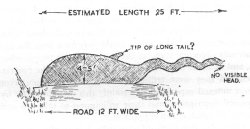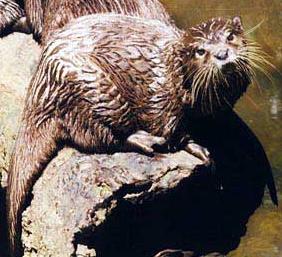
June 15, 2007

An old drawing of the animal described by Mr. and Mrs. George Spicer seen crossing the road near Dores, Scotland, one of the two examples examined today.
Ten days ago, I posted what became a very popular entry here (+125 comments), “Otter Nonsense”.
In discussing my appearance with Joe Nickell on CNN’s “Paula Zahn Now”, I noted that Nickel used a broad brush in debunking Lake Monster accounts.
The major “skeptic” argument presented during the CNN interview was Joe Nickell quickly telling and returning again to statements that all Lake Monster reports could be explained as being otters. While some mundane reports, needless to say, must be investigated with the appearance of otters in mind, Nickell’s global debunking was “otter nonsense.”
The mention of otters has figured in Lake Monster accounts from around the world. Here are two instances from a couple famed locations.

The common otter, also called the European river otter and the Eurasian otter (Lutra lutra).
An good example of how the otter has been used as background and an improbable explanation for an alleged Waterhorse seen near Loch Ness, Scotland, is the Mr. and Mrs. George Spicer incident of July 22, 1933.
Returning from a vacation in northern Scotland, the Spicers were driving south from Inverness along the Lakeshore Road at about 3:30-4:00 in the afternoon. The matter-of-fact, down-to-earth London banker and his wife had passed through Dores, and were on their way to Foyers. The weather was “fine” and visibility was good. Suddenly, as the car came up a slight incline, the bushes about 200 yards ahead became agitated, and out emerged an enormous animal, which crossed the small road, from left to right, in front of them. Startled, Spicer first braked then quickly accelerated instead, nearly striking the huge, dark long-necked creature in the process. The animal shuffled jerkily across the road, slipped through the underbrush, and seemed to vanish into the loch.
George Spicer was so upset by the encounter that he immediately penned a letter to The Courier. The Spicers described what they saw as a “terrible dark elephant grey, of loathsome texture, reminiscent of a snail.” Furthermore, Spicer said it had “a long neck which moved up and down in the manner of a scenic railway, and the body was fairly big, with a high back; but if there were any feet they must have been of the web kind, and as for a tail I cannot say, as it moved so rapidly, and when we got to the spot it had probably disappeared into the loch.” He also noted that the “dragon or prehistoric animal” appeared to be “carrying a small lamb or animal of some kind.”
The most controversial line in the letter dealt with the creature’s size: “Length six feet to eight feet and very ugly.” Various researchers and critics have been quick to note that Spicer changed the creature’s length in his retellings of the story. But it’s easy to see why. In the first letter, which was written in haste, Spicer did indeed write that the creature was six to eight feet in length. But later, while rethinking what he saw, how the creature had filled the 10-12 ft wide road, Spicer told Nessie author Constance Whyte that it was “the same length as the road is wide” and he told author Rupert T. Gould that it was probably at least 25 feet in length. Of course, in its first edition the Sunday Times of London made things even worse with a typo; they had the length at 300 feet! This was changed to 30 feet in later editions.
In the 1990s’ BBC program X-Creatures, British skeptic Adrian Shine revealed that he thought the Spicers had just seen an otter hopping across the road, distorted by heat waves. But even the largest male otter known makes a poor fit for Spicer’s creature, and the mild weather makes “heat waves” a rather unlikely possibility. The Field Guide to Lake Monsters, Sea Serpents, and Other Mystery Denizens of the Deep, pages 99-100.
And from Utah…
In 1860, The Deseret News quoted Marion Thomas and three brothers named Cook as having seen the thing in Bear Lake, opposite Swam Creek. Reportedly 20 feet long, they said it was covered with “light brown fur like that of an otter.” Two flippers, like fishermen’s oars, “extended upwards from the body” (whatever that means). They were so close they could have shot it with a rifle, if they had had one.
Commenting on this report, Peter Costello, in his In Search of Lake Monsters, said: “Preconceptions about what monsters must be has influenced them to speak of a serpent’s head, when from the exactness of the rest of the account we can see it must have been a mammal. The light brown fur, like an otter’s, is a detail worth noting. Clearly this is no otter, though. The Field Guide to Lake Monsters, Sea Serpents, and Other Mystery Denizens of the Deep, page 195.
Sources: Roland Binns, The Loch Ness Mystery Solved (Buffalo, NY: Prometheus, 1984); Loren Coleman and Patrick Huyghe, The Field Guide to Lake Monsters, Sea Serpents, and Other Mystery Denizens of the Deep, (New York: Tarcher/Penguin, 2003); Peter Costello, In Search of Lake Monsters (New York: Coward, McCann, and Geoghegan, 1974); Rupert Gould, The Loch Ness Monster and Others (London: Geoffrey Bles: London, 1934); Constance Whyte, More Than a Legend: The Story of the Loch Ness Monster (London: Hamish Hamilton, 1957).
About Loren Coleman
Loren Coleman is one of the world’s leading cryptozoologists, some say “the” leading living cryptozoologist. Certainly, he is acknowledged as the current living American researcher and writer who has most popularized cryptozoology in the late 20th and early 21st centuries.
Starting his fieldwork and investigations in 1960, after traveling and trekking extensively in pursuit of cryptozoological mysteries, Coleman began writing to share his experiences in 1969. An honorary member of Ivan T. Sanderson’s Society for the Investigation of the Unexplained in the 1970s, Coleman has been bestowed with similar honorary memberships of the North Idaho College Cryptozoology Club in 1983, and in subsequent years, that of the British Columbia Scientific Cryptozoology Club, CryptoSafari International, and other international organizations. He was also a Life Member and Benefactor of the International Society of Cryptozoology (now-defunct).
Loren Coleman’s daily blog, as a member of the Cryptomundo Team, served as an ongoing avenue of communication for the ever-growing body of cryptozoo news from 2005 through 2013. He returned as an infrequent contributor beginning Halloween week of 2015.
Coleman is the founder in 2003, and current director of the International Cryptozoology Museum in Portland, Maine.
Filed under Cryptotourism, CryptoZoo News, Cryptozoology, Eyewitness Accounts, Lake Monsters, Loch Ness Monster, Year In Review